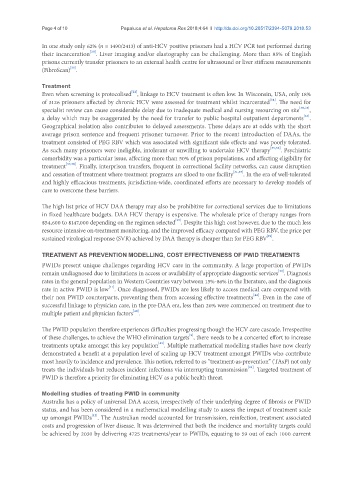Page 714 - Read Online
P. 714
Page 4 of 10 Papaluca et al. Hepatoma Res 2018;4:64 I http://dx.doi.org/10.20517/2394-5079.2018.53
In one study only 62% (n = 1490/2413) of anti-HCV positive prisoners had a HCV PCR test performed during
[28]
their incarceration . Liver imaging and/or elastography can be challenging. More than 85% of English
prisons currently transfer prisoners to an external health centre for ultrasound or liver stiffness measurements
[33]
(FibroScan) .
Treatment
[22]
Even when screening is protocolised , linkage to HCV treatment is often low. In Wisconsin, USA, only 18%
[34]
of 3126 prisoners affected by chronic HCV were assessed for treatment whilst incarcerated . The need for
specialist review can cause considerable delay due to inadequate medical and nursing resourcing on site [30,35] ,
[33]
a delay which may be exaggerated by the need for transfer to public hospital outpatient departments .
Geographical isolation also contributes to delayed assessments. These delays are at odds with the short
average prison sentence and frequent prisoner turnover. Prior to the recent introduction of DAAs, the
treatment consisted of PEG RBV which was associated with significant side effects and was poorly tolerated.
As such many prisoners were ineligible, intolerant or unwilling to undertake HCV therapy [35,36] . Psychiatric
comorbidity was a particular issue, affecting more than 50% of prison populations, and affecting eligibility for
treatment [37,38] . Finally, interprison transfers, frequent in correctional facility networks, can cause disruption
and cessation of treatment where treatment programs are siloed to one facility [31,35] . In the era of well-tolerated
and highly efficacious treatments, jurisdiction-wide, coordinated efforts are necessary to develop models of
care to overcome these barriers.
The high list price of HCV DAA therapy may also be prohibitive for correctional services due to limitations
in fixed healthcare budgets. DAA HCV therapy is expensive. The wholesale price of therapy ranges from
[39]
$54,600 to $147,000 depending on the regimen selected . Despite this high cost however, due to the much less
resource intensive on-treatment monitoring, and the improved efficacy compared with PEG RBV, the price per
[39]
sustained virological response (SVR) achieved by DAA therapy is cheaper than for PEG RBV .
TREATMENT AS PREVENTION MODELLING, COST EFFECTIVENESS OF PWID TREATMENTS
PWIDs present unique challenges regarding HCV care in the community. A large proportion of PWIDs
[40]
remain undiagnosed due to limitations in access or availability of appropriate diagnostic services . Diagnosis
rates in the general population in Western Countries vary between 15%-86% in the literature, and the diagnosis
[41]
rate in active PWID is low . Once diagnosed, PWIDs are less likely to access medical care compared with
[42]
their non PWID counterparts, preventing them from accessing effective treatments . Even in the case of
successful linkage to physician care, in the pre-DAA era, less than 20% were commenced on treatment due to
[40]
multiple patient and physician factors .
The PWID population therefore experiences difficulties progressing though the HCV care cascade. Irrespective
[9]
of these challenges, to achieve the WHO elimination targets , there needs to be a concerted effort to increase
[43]
treatments uptake amongst this key population . Multiple mathematical modelling studies have now clearly
demonstrated a benefit at a population level of scaling up HCV treatment amongst PWIDs who contribute
most heavily to incidence and prevalence. This notion, referred to as “treatment-as-prevention” (TAsP) not only
[44]
treats the individuals but reduces incident infections via interrupting transmission . Targeted treatment of
PWID is therefore a priority for eliminating HCV as a public health threat.
Modelling studies of treating PWID in community
Australia has a policy of universal DAA access, irrespectively of their underlying degree of fibrosis or PWID
status, and has been considered in a mathematical modelling study to assess the impact of treatment scale
[12]
up amongst PWIDs . The Australian model accounted for transmission, reinfection, treatment associated
costs and progression of liver disease. It was determined that both the incidence and mortality targets could
be achieved by 2030 by delivering 4725 treatments/year to PWIDs, equating to 59 out of each 1000 current

